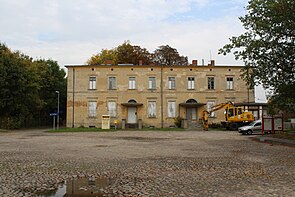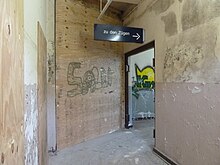Passow train station (Uckermark)
| Passow (Uckermark) | |
|---|---|
|
Reception building and forecourt (2017)
|
|
| Data | |
| Location in the network | Separation station |
| Design | Through station |
| Platform tracks | 1 |
| abbreviation | WPS |
| IBNR | 8012611 |
| Price range | 6th |
| opening | 1843 |
| Profile on Bahnhof.de | Passow__Uckermark_ |
| Architectural data | |
| Architectural style | classicism |
| architect | Friedrich Neuhaus |
| location | |
| City / municipality | Passow |
| Place / district | Turning mark |
| country | Brandenburg |
| Country | Germany |
| Coordinates | 53 ° 8 '56 " N , 14 ° 6' 4" E |
| Height ( SO ) | 11 m above sea level NN |
| Railway lines | |
|
|
| Railway stations in Brandenburg | |
The Passow (Uckermark) train station is in the Passow municipality on the Szczecin Railway . The train station opened in 1843 is one of the oldest in the state of Brandenburg . The station had its greatest importance in the first years of its existence, when it became a connection station for traffic to Prenzlau and on towards Greifswald and Stralsund . However, plans to make Passow the starting point of a railway line to these places came to nothing. After the Angermünde-Stralsund Railway went into operation in 1863, the station was only of local importance. In 1963 the Passow – Schwedt railway went into operation, a purely freight line that serves the PCK refinery from Passow . The station building is a listed building.
Location and name
The station is located at route kilometer 89.3 of the Berlin – Szczecin railway line (the kilometrage begins in the former Szczecin station, today's North Station in Berlin). The route runs roughly from southwest to northeast through the Welsebruch on the corridor of the Wendemark district of Passow. The eponymous village Passow is about a kilometer southeast of the train station on the other side of the catfish . In the area of the train station, the country road from Schwedt to Prenzlau, the later federal highway 166 , crosses the railway line. After the year 2000, an overpass was built for the main road southwest of the station. The place Passow is the seat of the municipality of the same name in the Oder-Welse district in the Uckermark district . The station was initially called Passow (Uckerm.) , After 1945 Passow (Kr Angermünde) and since the mid-1990s again Passow (Uckermark) .
history
The station went into operation on August 16, 1843 when the Berlin-Szczecin Railway was extended from Angermünde to Szczecin . Passow and Tantow were initially the only stopovers between the two cities. The main function of the station was above all to connect the city of Prenzlau to the railway; all traffic in the direction of Pasewalk , Stralsund and Rügen also passed through Passow. Accordingly, the station was set up largely at the instigation of the Prenzlauer Magistrate, and a road between Passow and Prenzlau was created. Up to 75 stagecoaches were available to pick up passengers from Passow. Shortly after the line opened, there were plans to build a railway line from Passow via Prenzlau, Pasewalk and Greifswald to Stralsund. These plans were also pursued in the 1850s, the Berlin-Stettiner Eisenbahn-Gesellschaft received on November 16, 1853, King Friedrich Wilhelm IV's approval to build the line. However, the company demanded that the state of Prussia should provide the site for railway construction free of charge as well as additional financial aid. This was refused. Protests against “dat Dübelstüg” (devil's stuff) railroad also stirred up among the landowners in the towns of Briest and Fredersdorf north of Passow . So the railway to the north was finally built from Angermünde and went into operation in 1863. The Passow train station then lost its national importance.
After the Second World War, the importance of the line and the train station continued to decline, as Szczecin came to Poland through the Oder-Neisse border . Passow was only served by a few trains commuting between Angermünde and the border town of Tantow, sometimes further to Rosow . The station was given a new role in freight transport when the connecting line to the PCK plant in Schwedt from Passow went into operation at the end of 1963. The second track between Angermünde and Passow , which was dismantled after the end of the war as a reparation payment, was later rebuilt for freight traffic . On December 20, 1987, the Passow station from Angermünde and further on the connecting line to Stendell was provided with electrical catenary.
In 2005 the section between Angermünde and Passow was connected to an electronic signal box , the locally operated signal boxes from 1934 went out of operation.
In 2017, the listed water tower in the train station was demolished, which presumably dates from the time the line was opened around 1842.
passenger traffic
In the years before the First World War , the train station in Passow was served by between seven and nine pairs of trains daily, which ran between Angermünde (mostly coming from Berlin) and Stettin. Express trains did not stop at the station. In the 1930s, too, the offer remained roughly the same. After the Second World War, passenger traffic was significantly thinned out. Until the fall of the Berlin Wall, the offer was limited to five pairs of trains between Angermünde and Tantow. The border crossing to Poland was only used by one or two pairs of express trains a day that did not stop in Passow. It was not until 1994 that the first local trains ran again across the border crossing, so that Passow again had a direct connection to the Szczecin Główny train station (Stettin Hauptbahnhof). In the 2012 timetable, Passow is served by six pairs of trains (one of them only on weekdays) on the RB 66 line between Angermünde (with connections to and from Berlin) and Szczecin, plus an afternoon train direct from Berlin-Gesundbrunnen.
| line | course | Tact |
|---|---|---|
| RB / RE 66 | ( Berlin Gesundbrunnen - Bernau (b Berlin) - Eberswalde Hbf -) Angermünde - Passow (Uckerm) - Tantow - Szczecin Gł | 7–8 pairs of trains a day |
Several bus lines stop at the station forecourt, including to Prenzlau via Gramzow and Schwedt.
Investments
The station has three continuous tracks, the line in the direction of the PCK refinery can be reached from all tracks, the line to the Polish border only from two of these tracks. The station building is on the north-western side of the tracks facing away from the town. In front of it there is a forecourt with bus stops and parking facilities. Only the house platform at the entrance building is available for passenger traffic. The intermediate platform, which can only be reached via a track crossing, is no longer used.
The reception building on the is a classical two-storey building in L-shape, with one long side facing the platform and the other facing the forecourt. Passow and the train station buildings in Bernau , Neustadt-Eberswalde , Angermünde and Tantow are considered to be the “journeyman piece” of Friedrich Neuhaus , who a few years later became known as the construction director of the Berlin-Hamburg railway . The Passow station building with its strict classicist forms is the only one of the station buildings of the Szczecin Railway that still has almost its original shape. It is empty and is not in use, until 2013 access to the platform was through the building, and since then around the building. The listed building is privately owned and was offered for sale to the municipality in 2012. On the south-east side of the tracks there is a signal box and a loading line, both of which are no longer used.
Up to and including Passow, the Szczecin Railway is electrified and double-tracked, to the northeast of it single-track and without overhead lines. The connecting line to the PCK refinery is single-track and electrified.
Web links
Individual evidence
- ↑ Query of the course book route 209.66 at Deutsche Bahn.
- ↑ a b History of the Passow community. (No longer available online.) Amt Oder-Welse, archived from the original on January 14, 2012 ; Retrieved June 7, 2012 . Info: The archive link was inserted automatically and has not yet been checked. Please check the original and archive link according to the instructions and then remove this notice.
- ^ Peter Bley: Berliner Nordbahn. 125 years of the Berlin – Neustrelitz – Stralsund railway . VBN Verlag B. Neddermeyer, Berlin 2002, ISBN 3-933254-33-7 , p. 5 .
- ^ Peter Bley: Berliner Nordbahn. 125 years of the Berlin – Neustrelitz – Stralsund railway . VBN Verlag B. Neddermeyer, Berlin 2002, ISBN 3-933254-33-7 , p. 7 .
- ^ Holger Kötting: List of German signal boxes. In: stellwerke.de. Retrieved May 18, 2016 .
- ↑ Bahn-Report , 2/2018, p. 41.
- ↑ Tracks in service facilities. Passow train station (Uckermark). (No longer available online.) Deutsche Bahn AG, formerly in the original ; Retrieved June 7, 2012 . ( Page no longer available , search in web archives )
- ^ Sabine Bohle-Heintzenberg, Manfred Hamm: Architecture & Beauty: the Schinkel School in Berlin and Brandenburg . Transit, Berlin 1997, ISBN 3-88747-121-0 , p. 162 .
- ↑ List of monuments of the state of Brandenburg, district of Uckermark. (PDF; 297 kB) (No longer available online.) December 31, 2011, archived from the original on September 23, 2015 ; Retrieved June 7, 2012 . Info: The archive link was inserted automatically and has not yet been checked. Please check the original and archive link according to the instructions and then remove this notice.
- ↑ Alexander Kempf: From Schönow to Dreieich. In: moz.de. April 5, 2012, Retrieved June 7, 2012 .




